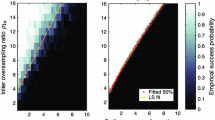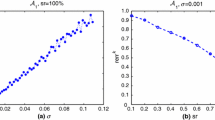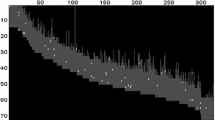Abstract
Many applications in data analysis rely on the decomposition of a data matrix into a low-rank and a sparse component. Existing methods that tackle this task use the nuclear norm and \(\ell _1\)-cost functions as convex relaxations of the rank constraint and the sparsity measure, respectively, or employ thresholding techniques. We propose a method that allows for reconstructing and tracking a subspace of upper-bounded dimension from incomplete and corrupted observations. It does not require any a priori information about the number of outliers. The core of our algorithm is an intrinsic Conjugate Gradient method on the set of orthogonal projection matrices, the so-called Grassmannian. Non-convex sparsity measures are used for outlier detection, which leads to improved performance in terms of robustly recovering and tracking the low-rank matrix. In particular, our approach can cope with more outliers and with an underlying matrix of higher rank than other state-of-the-art methods.






Similar content being viewed by others
References
Absil PA, Mahony R, Sepulchre R (2008) Optimization algorithms on matrix manifolds. Princeton University Press, Princeton
Balzano L, Nowak R, Recht B (2010) Online identification and tracking of subspaces from highly incomplete information. In: 2010 48th Annual allerton conference on communication, control, and computing, pp 704–711
Boumal N, Absil PA (2011) RTRMC: a Riemannian trust-region method for low-rank matrix completion. In: Shawe-Taylor J, Zemel RS, Bartlett P, Pereira F, Weinberger KQ (eds) Advances in neural information processing systems, pp 406–414
Cai J, Candès EJ, Shen Z (2010) A singular value thresholding algorithm for matrix completion. SIAM J Optim 20:1956–1982
Candès E, Li X, Ma Y, Wright J (2011) Robust principal component analysis? J ACM 58(3):1–37
Chartrand R, Staneva V (2008) Restricted isometry properties and nonconvex compressive sensing. Inverse Probl 24(3):1–14
Chen Y, Xu H, Caramanis C, Sanghavi S (2011) Robust matrix completion and corrupted columns. In: International conference on machine learning, vol 2, pp 873–880
Ding C, Zhou D, He X, Zha H (2006) R1-PCA: rotational invariant L1-norm principal component analysis for robust subspace factorization. In: 23rd International conference on Machine learning. ACM, New York, pp 281–288
Gasso G, Rakotomamonjy A, Canu S (2009) Recovering sparse signals with a certain family of nonconvex penalties and DC programming. IEEE Trans Signal Process 57(12):4686–4698
Golub H, Van Loan CF (1996) Matrix computations. Johns Hopkins University Press, Baltimore
He J, Balzano L, Szlam A (2012) Incremental gradient on the Grassmannian for online foreground and background separation in subsampled video. In: IEEE conference on computer vision and pattern recognition, pp 1568–1575
Helmke U, Hüper K, Trumpf J (2007) Newton’s method on Grassmann manifolds. ArXiv e-prints 0709.2205
Keshavan RH, Montanari A (2010) Matrix completion from noisy entries. J Mach Learn Res 11:2057–2078
Kleinsteuber M, Hüper K (2007) An intrinsic CG algorithm for computing dominant subspaces. In: IEEE international conference on acoustics, speech and signal processing, vol 7, pp 1405–1408
Kwak N (2008) Principal component analysis based on l1-norm maximization. IEEE Trans Pattern Anal Mach Intell 30(9):1672–1680
Li L, Huang W, Gu IYH, Tian Q (2004) Statistical modeling of complex backgrounds for foreground object detection. IEEE Trans Image Process 13(11):1459–1472
Lin Z, Chen M, Wu L, Ma Y (2010) The augmented lagrange multiplier method for exact recovery of corrupted low-rank matrices. Arxiv, preprint arXiv:10095055 arXiv:1009.5055v2
Meyer G, Bonnabel S, Sepulchre R (2011) Linear regression under fixed-rank constraints: a Riemannian approach. In: International conference on machine learning, pp 545–552
Ring W, Wirth B (2012) Optimization methods on Riemannian manifolds and their application to shape space. SIAM J Optim 22(2):596–627
Shalev-Shwartz S, Gonen A, Shamir O (2011) Large-scale convex minimization with a low-rank constraint. In: International conference on machine learning, pp 329–336
Shalit U, Weinshall D, Chechik G (2010) Online learning in the manifold of low-rank matrices. Adv Neural Inf Process Syst 23:2128–2136
Shen Y, Wen Z, Zhang Y (2012) Augmented Lagrangian alternating direction method for matrix separation based on low-rank factorization. Optim Methods Softw 1–25
Waters AE, Sankaranarayanan AC, Baraniuk RG (2011) SpaRCS: recovering low-rank and sparse matrices from compressive measurements. In: Shawe-Taylor J, Zemel RS, Bartlett P, Pereira F, Weinberger KQ (eds) Advances in neural information processing systems, pp 1089–1097
Wright J, Ganesh A, Rao S, Peng Y, Ma Y (2009) Robust principal component analysis: exact recovery of corrupted low-rank matrices via convex optimization. In: Bengio Y, Schuurmans D, Lafferty J, Williams CKI, Culotta A (eds) Advances in neural information processing systems, pp 2080–2088
Zhou T, Tao D (2011) GoDec: randomized low-rank & sparse matrix decomposition in noisy case. In: International conference on machine learning, pp 33–40
Author information
Authors and Affiliations
Corresponding author
Additional information
This work has been supported by the DFG excellence initiative research cluster CoTeSys.
Rights and permissions
About this article
Cite this article
Hage, C., Kleinsteuber, M. Robust PCA and subspace tracking from incomplete observations using \(\ell _0\)-surrogates. Comput Stat 29, 467–487 (2014). https://doi.org/10.1007/s00180-013-0435-4
Received:
Accepted:
Published:
Issue Date:
DOI: https://doi.org/10.1007/s00180-013-0435-4




